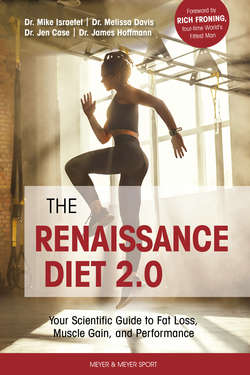Читать книгу The Renaissance Diet 2.0 - Mike Israetel, James Hoffmann - Страница 51
На сайте Литреса книга снята с продажи.
Minimum, Maximum, and Recommended Daily Carbohydrate Intake
ОглавлениеGlucose can be obtained from other macronutrients, albeit less efficiently. The human body does not actually need any carbohydrates from the diet for basic survival and health. So the minimum carbohydrate intake could be set at zero. The most abundant sources of needed vitamins, minerals, phytochemicals, and fiber, however, are vegetables, fruits, and whole grains, all of which contain carbs. While most of these micronutrients can be supplemented, many are absorbed more efficiently when consumed via whole foods, so eliminating carbs entirely presents some risk to health.
How much plant-based food must be consumed to meet micronutrient needs for health depends on which foods are consumed. If a high diversity of colorful veggies and fruits are eaten regularly, the micronutrients they contain will satisfy health requirements with relatively low-carb intakes. On the other hand, if more processed grains are the primary source, a considerably higher amount of carb-rich food must be eaten to ensure adequate micronutrient intake.
The ceiling for carbohydrate intake is best set by using CCH to dictate carb amounts once protein and fat at are their respective minima. Within this constraint, there is no notable downside to very high carb consumption. These recommendations are fairly vague, so we will outline some specifics for carb intake here.
